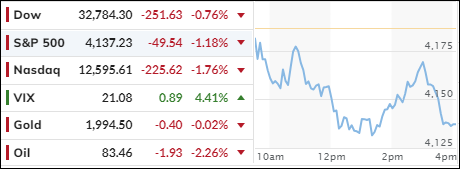
- Moving the markets
It was another brutal day for stocks, as the Nasdaq Composite plunged deeper into the red zone, thanks to Meta’s disappointing earnings. The tech giant formerly known as Facebook failed to wow investors with its metaverse vision, and its stock dropped more than 10%.
The Nasdaq Composite is now down more than 10% from its July high, joining the correction club with the S&P 500, which also slipped below that mark today.
The main culprit behind this sell-off is the rising bond yields, which make stocks look less attractive. The 10-year Treasury yield flirted with 5% this month, a level not seen since 2007, before settling at 4.848% today.
Big tech earnings have been a mixed bag so far, and the market is not impressed. Amazon and Apple are the last ones to report this week, but they face a tough challenge amid the slowing US economy and the supply chain woes.
The third-quarter GDP report did not help either, as it showed that the US economy grew faster than expected, at 4.9% annualized. This might sound like good news, but it also means that the Fed has less reason to cut rates or ease its monetary policy.
The Magnificent 7 stocks, which include Meta, Amazon, Apple, Microsoft, Google, Netflix, and Tesla, have lost about $1 trillion in market value in the last two weeks, as bond yields and big tech moved in opposite directions.
The market also shrugged off some attempts to spark a rally, such as short squeezes, gold prices, or oil prices.
The AI boom/covid/crypto boom/bust cycle is still in play, and it does not look pretty. Can Amazon save the day with its earnings report later today? Or will it be another nail in the coffin for the tech sector?
2. “Buy” Cycle (12/1/22 to 9/21/2023)
The current Domestic Buy cycle began on December 1, 2022, and concluded on September 21, 2023, at which time we liquidated our holdings in “broadly diversified domestic ETFs and mutual funds”.
Our International TTI has now dipped firmly below its long-term trend line, thereby signaling the end of its current Buy cycle effective 10/3/23.
We have kept some selected sector funds. To make informed investment decisions based on your risk tolerance, you can refer to my Thursday StatSheet and Saturday’s “ETFs on the Cutline” report.
Considering the current turbulent times, it is prudent for conservative investors to remain in money market funds—not bond funds—on the sidelines.
3. Trend Tracking Indexes (TTIs)
The markets suffered another sharp decline today, as the S&P 500 joined the Nasdaq in entering a bear market. This means that both indexes have fallen more than 10% from their recent peaks.
This was expected by our TTIs, which indicated a bearish trend change last month. As a result, our indexes are now well below the threshold that separates a bullish and a bearish market.
This is how we closed 10/26/2023:
Domestic TTI: -6.75% below its M/A (prior close –6.56%)—Sell signal effective 9/22/2023.
International TTI: -3.97% below its M/A (prior close -3.40%)—Sell signal effective 10/3/2023.
All linked charts above are courtesy of Bloomberg via ZeroHedge.
Contact Ulli